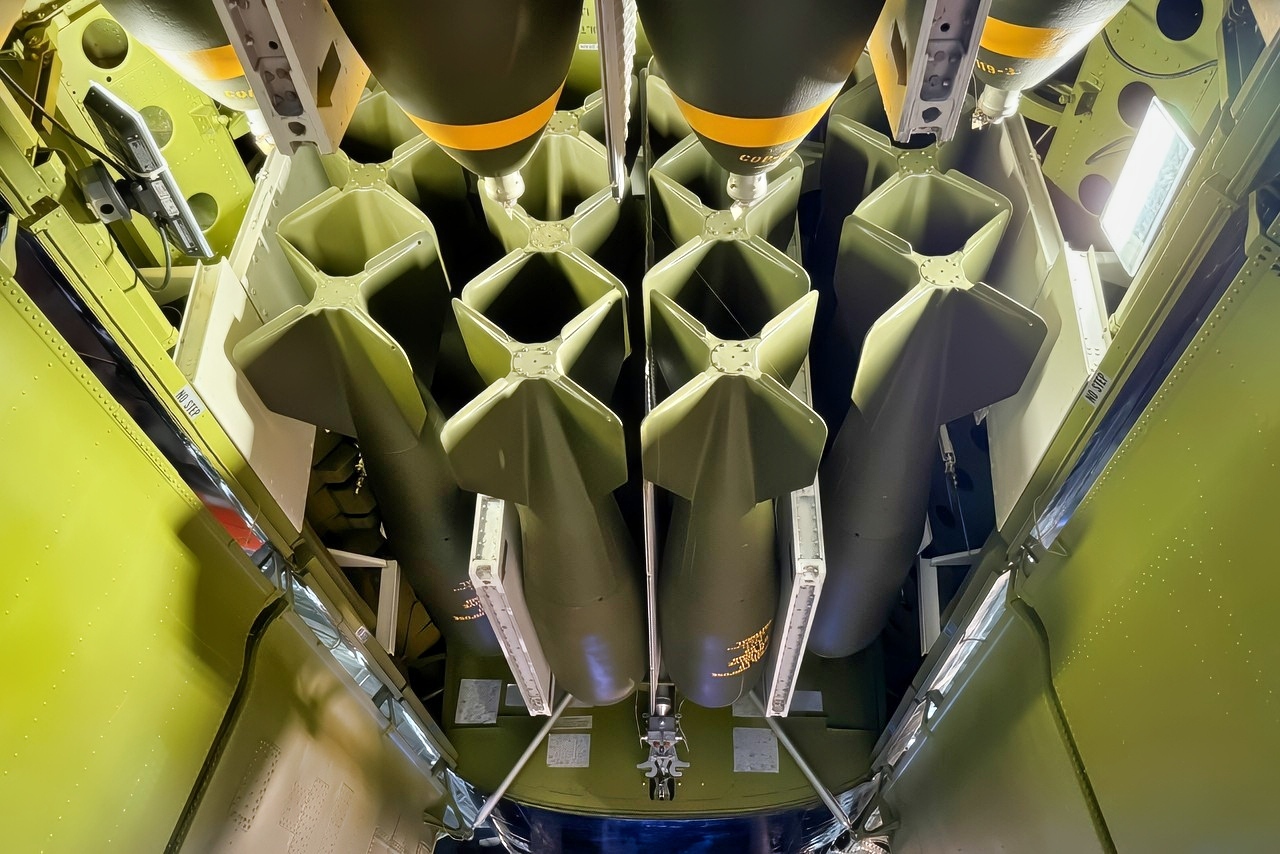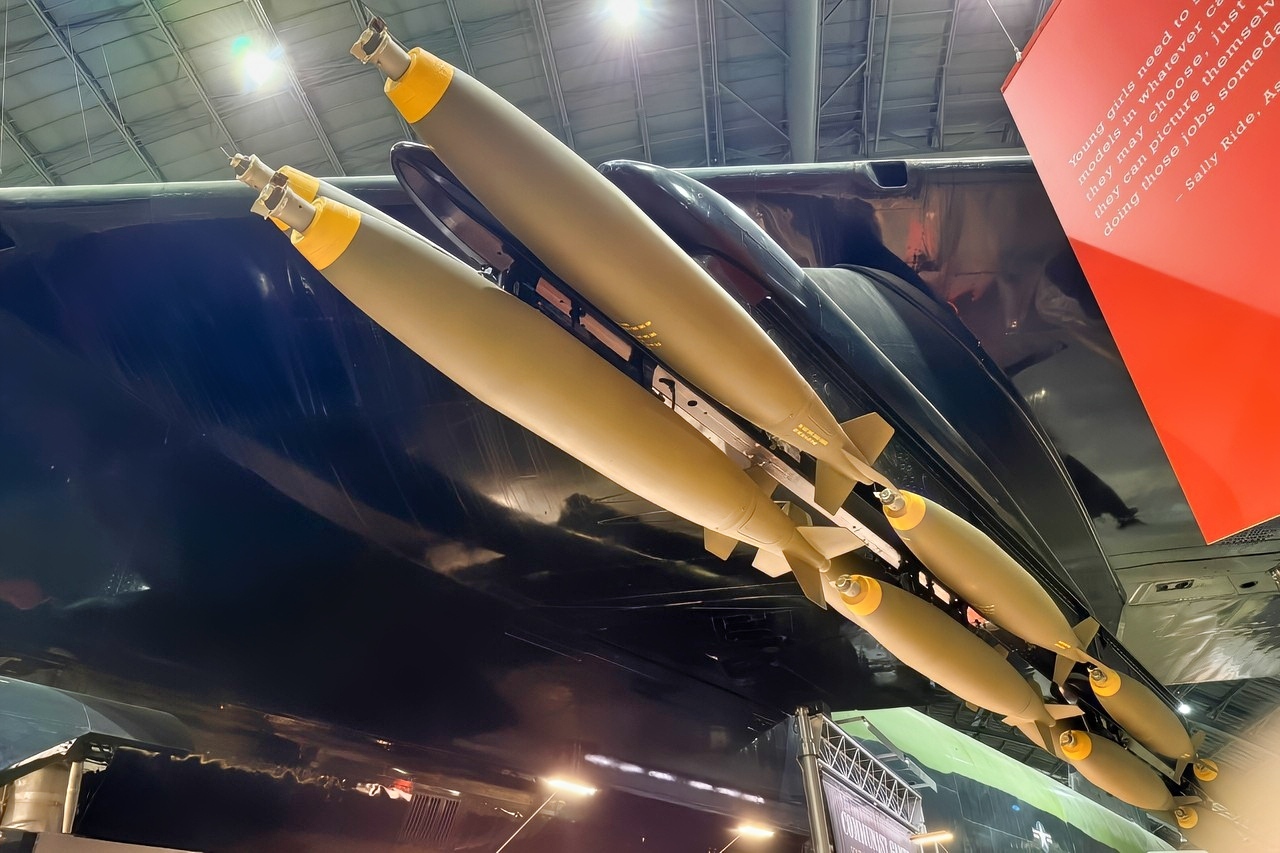Key Points and Summary – The Boeing B-52 Stratofortress, nicknamed the “BUFF,” is an aviation marvel, still serving after more than 70 years.
-It is America’s most battle-proven bomber, famed for its devastating psychological impact.

B-52D Bomber at USAF Museum. Image Credit: National Security Journal.
-During Desert Storm, Iraqi troops surrendered at the mere sight of it, and its bombing campaigns in Vietnam are credited with breaking North Vietnam’s will to fight.
-Far from retiring, this eight-engine bomber is being upgraded to continue service for decades to come—a testament to a design so enduring that three generations of the same family have flown it into combat.
B-52 Bomber: A Historical Look and Combat Experience
Incredibly, the Boeing B-52 Stratofortress AKA the “BUFF” (“Big Ugly Fat ******,” or “Big Ugly Fat Fellow” if you’re in polite company) is still going strong after seven-plus decades, and is therefore older than the crews flying it.
Indeed, back on October 25, 2012 (when the BUFF was still a mere sexagenarian), Air Force Global Strike Command Public Affairs ran a story on then-USAF Capt. Daniel Welch of the 23rd Bomb Squadron at Minot AFB, ND, a B-42H Aircraft Commander whose grandfather, Col. Don Sprague (USAF, Ret.), and his father, Lt. Col. Don Welch (USAF, Ret.), were also B-52 aviators!
Yet in spite of its age, this mighty, venerable warbird isn’t going away anytime soon. After all, it’s the most versatile and battle-proven out of all of America’s strategic bombers. With all due respect to the BUFF Rockwell B-1B Lancer and the Northrop B-2 Spirit, no other weapons system in America’s arsenal has dished out punishment to enemy forces quite like the B-52.
B-52 Initial History
The BUFF made her maiden flight on Tax Day, April 15, 1952, in the prototype form known as the YB-52. The bomber traces its roots back to November 1945, when the US Air Force (then still officially known as the US Army Air Forces [USAAF]) issued a requirement for a new strategic bomber.

Bombs Inside the B-52 Bomber. Photo taken by Harry J. Kazianis/National Security Journal.
Boeing won the contract bid on June 5, 1946. The warbird’s design evolved from a straight-wing aircraft powered by six turboprop engines to the final prototype B-52s with swept wings and eight turbojet engines.
A total of 744 B-52 airframes were built, divvied across eight different production model variants. The final specimen of the newest iteration, the B-52H, rolled off the assembly lines back in October 1962.
B-52H Technical Specifications and Vital Stats
Crew: 5 (pilot, copilot, weapon systems officer [WSO or “Wizzo”], navigator, electronic warfare officer [EWO])
Fuselage Length: 159 ft 4 in (48.5 m)
Wingspan: 185 ft 0 in (56.4 m)
Height:40 ft 8 in (12.4 m)
Empty Weight: 185,000 lbs. (83,250 kg)
Maximum Takeoff Weight: 488,000 lbs. (221,323 kg)
Powerplant: 8 × Pratt & Whitney TF33-P-3/103 turbofans, each generating 17,000 lbf (76 kN) of thrust
Max Airspeed: 650 mph (1,050 km/h, 560 knots)
Combat Range: 8,800 statute miles (14,200 km, 7,600 nautical miles)
Service Ceiling: 50,000 ft (15,000 m)
Armament: Approximately 70,000 pounds (32,000 kg) of various types of ordnance; bombs, mines, cruise missiles, etc.
Regarding the armament, the Stratofortress also featured tail guns for self-defense during its first 39 years of existence, initially equipped with a quad turret of Browning M2 “Ma Deuce” .50-caliber machine guns and later a single Vulcan M61 20mm Vulcan cannon.
Alas, the defensive guns went the way of the dodo bird on September 16, 1991, when then-commander of Strategic Air Command (SAC) Gen. George L. Butler made the decision to eliminate the tail gunner position as a cost-saving measure. The last airman to serve as a BUFF tail gunner, Chief Master Sergeant (CMSgt) Rob Wellbaum, retired in 2020.

B-52 Bomber Bombs Ready to Go. Image Credit: National Security Journal.
Operational History/Combat Performance
What can be said here that hasn’t been said already? For the sake of brevity and spatial limitations, we’ll narrow it down to an admittedly subjective list of the B-52’s Top 3 combat moments:
–Operation Linebacker II (Vietnam War), 18 – 29 December 1972: The so-called “Christmas bombing” of Hanoi and Haiphong Harbor in North Vietnam. The targets consisted of rail yards and marshaling areas, petroleum storage facilities, missile storage sites, docks, and warehouses.
American POWs holed up at the infamous “Hanoi Hilton” prison, like Medal of Honor recipient Adm. James Bond Stockdale, noted how the B-52 strikes shattered the arrogance of their North Vietnamese tormentors: “The shock was there; our enemy’s will was broken.” The North Vietnamese made their way back to the negotiating table. Sir Robert Thompson – mastermind of the British victory against Communist insurgents in the Malayan Emergency – assessed Linebacker II thusly: “In my view…you had won the war. It was over!”
–1991 Persian Gulf War (AKA Operation Desert Storm): The mighty BUFF was called to rain down hell upon then-Iraqi dictator Saddam Hussein’s elite troops with merciless and incessant carpet-bombing raids. Physical damage to Republican Guard assets was modest, with maybe 50 of the Guards’ T-72 main battle tanks destroyed.
But the psychological damage inflicted by the American heavy bombers was disproportionately impactful. One Republican Guard officer said he surrendered his unit because of B-52 strikes. On being informed by his interrogator that his unit was never hit by B-52s, he replied, “But I saw one that had been attacked.”
–Operation Allied Force (Kosovo air campaign, 1999): The NATO air campaign intended to stop Serbian strongman Slobodan Milosevic’s ethnic cleansing campaign against the Albanian Muslim majority populace living in Kosovo. It was initially limited in scope and lacked intensity. It failed to fully leverage the potential of airpower.
That was the case, at least, until B-52s were called upon to make the sort of history they had made in the two aforementioned wars, carpet-bombing the living heck out of enemy troop concentrations. A single such BUFF strike against a massed Serb troop formation of roughly 800 to 1,000 soldiers on June 8, 1999, wiped out more than half their number and left the rest to flee in abject terror.
The Way Forward for the BUFF
As already noted at the beginning of this article, the B-52 ain’t going anywhere anytime soon. Indeed, it’s slated for more upgrades, with the upcoming designation of B-52J.
Meanwhile, a considerable number of older BUFF airframes have been preserved for posterity at military bases and museums around the United States, as well as in Australia, South Korea, and the United Kingdom.
To cite just two examples, there’s Tail No. 55-0057, a B-52D located on the OODA Loop driveway at Maxwell AFB, Alabama, and Tail No. 56-0665, a B-52D displayed proudly at the National Museum of the United States Air Force at Wright-Patterson AFB, Ohio (in the vicinity of Dayton).
We Went Right Into a B-52 Bomb Bay
National Security Journal visited a B-52D bomber at the U.S. Air Force Museum in Dayton, Ohio, and was able to film right under the warplane with its bomb bay doors open. You see the video below. It was filmed on July 19, 2025:
About the Author: Christian D. Orr, Defense Expert
Christian D. Orr is a Senior Defense Editor. He is a former Air Force Security Forces officer, Federal law enforcement officer, and private military contractor (with assignments worked in Iraq, the United Arab Emirates, Kosovo, Japan, Germany, and the Pentagon). Chris holds a B.A. in International Relations from the University of Southern California (USC) and an M.A. in Intelligence Studies (concentration in Terrorism Studies) from American Military University (AMU).
More Military
We Almost Touched the F-117 Stealth Fighter











Pingback: China's H-6 Bomber Summed Up in 4 Words - National Security Journal